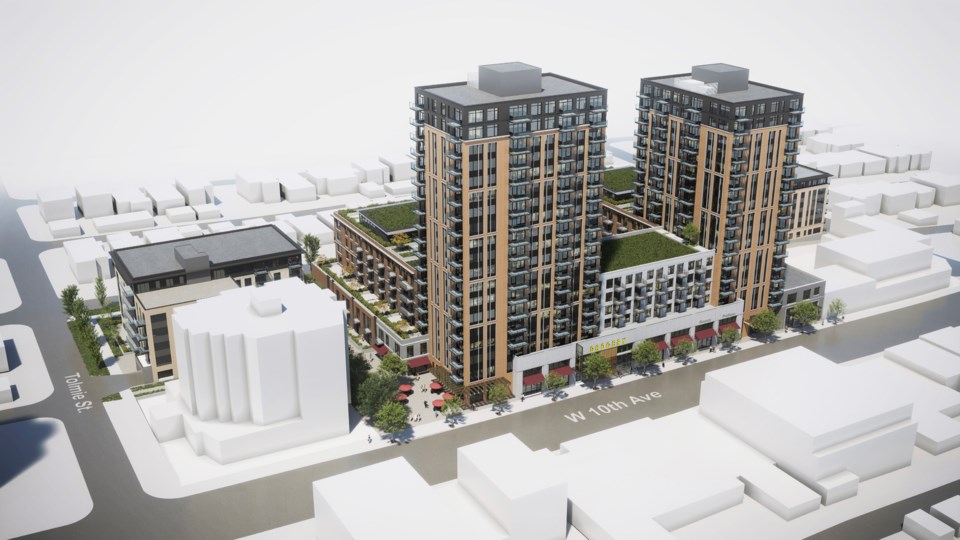Debate is growing in Vancouver’s Point Grey neighbourhood as a proposed high-density development sparks conversation about increasing affordable housing supply and adding child care.
The site, located near the corner of 10th Avenue West and Tolmie Street, was home to a Safeway grocery store up until 2018. The lot is currently being used as a community garden.
Christina DeMarco, an urban planning instructor at Simon Fraser University speaking on behalf of the Friends of Point Grey Village neighbourhood association, said that residents have been waiting a long time for a new development on that lot.
“This really important site could help the village. The main community focus is how can such a large, important site really enhance the village and the prosperity of businesses? We're very much for housing and especially affordable housing and, of course, we're delighted the grocery store will be replaced,” she said.
“But we're finding a lot of deficiencies in the proposed development.”
One deficiency, according to DeMarco, is that the proposed development has higher density than what is mandated for areas with similar zoning, such as Fourth Avenue West, in the city’s Broadway Plan. The plan outlines development goals along the Broadway thoroughfare.
On the other side of the debate is the Vancouver Area Neighbours Association, which supports the development.
“We have a consistent pattern in Vancouver of these things not getting built and these things taking forever to get built,” said Peter Dowdy, speaking on behalf of the association.
“We think it should go ahead as planned.”
The development application is being considered under the Moderate Income Rental Housing Pilot Program. The program mandates that 100 per cent of the units in the project be secured rental, with 20 per cent of the units having below-market rent.
Dowdy described having the development as part of this program as “a pretty rare unicorn.”
Developer BentallGreenOak (BGO) is proposing a mixed-use development that features three buildings: two smaller buildings at six storeys and a larger, central complex with two towers at 17 and 19 storeys.
BGO declined an interview request.
The project is set to provide 455 market rental units and 114 moderate-income rental units for a total of 569 units.
The next step will be for city staff to make a recommendation on the project. If staff determines it meets the city’s policy objectives, it will be brought before city council for a vote on whether it will go to a public hearing.
The Point Grey site is located in Premier David Eby’s riding. Housing supply and affordability have been central to policies his government has introduced since he’s been at the helm.
Eby did not return Glacier Media's request for comment by publication time.
A battle between density and daycare
DeMarco said that after chatting with local residents, the “one clear, missing link” is the inclusion of child-care space in the project.
“We were thinking, ‘Well, all this new money from the province and the federal government for child care, so surely, a housing development of over 500 units should provide a child-care facility,” she said.
Child-care need in the West Point Grey area is slightly below the citywide average for children aged zero to 12, according to December 2023 data from the city.
“West Point Grey is relatively well served for children aged three to five years,” said the city in an email.
The area has “the second lowest child-care service level for children under three years of age,” meaning that only two per cent of child-care needs for infants and toddlers in West Point Grey can be met with the current child-care supply versus the citywide average of 27 per cent needs met.
“However, due to the relatively small number of children residing in West Point Grey, the actual shortfall of child care in the neighbourhood is approximately 110 spaces, compared to the citywide average of 230 spaces per neighbourhood,” said the city.
In contrast, Renfrew Collingwood has a shortfall of 464 child-care spaces for children under three.
“There's definitely demand there for daycare … but I think that we're creating a competition between housing and child-care spaces that doesn't need to exist,” said Dowdy.
He said that for more child-care space to be added, it would come at the cost of the moderate rental income units.
“Realistically, the way that you would support these additional amenities is by changing the project to be a market, strata condo building … those affordable rental units would vanish.”
DeMarco said there could be “innovative solutions where one of those buildings becomes co-op housing and so that changes the way that the developer contributes to that below-market housing.”
She added that the design can be further rethought to put most of the density at the back of the site.
“We want the housing at the grocery store [site], but we can also do things to provide enduring value for the village in the coming years.”



